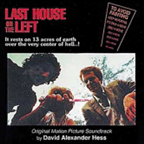Children Shouldn’t Play With Dead Things

April 21, 2005
BY DENEZ McADOOStaff Writer
The Last House on the Left1972Director – Wes Craven”To avoid fainting, keep repeating, “It’s only a movie… It’s only a movie…”84 min – unrated
There seems to be two types of people on the earth. First, there are the people who see horror films only as shallow, juvenile, and exploitative excursions in shock-cinema that have little to no meaningful substance that would give the films some amount of redeemable qualities. Then, there are the type of people who just plain old love chainsaws.
Well, horror films still bring in the figures down at the box office so that must mean there is a significant number of freaky-freaks coming out of the woodwork who have an insatiable lust for being brought to the brink of crapping their pants. But this column exists to make the argument that even the trashiest and most blood-soaked gore films serve both as a reflection and often a subconscious articulation of the society in which they were produced.
For example, acclaimed director Wes Craven’s directorial debut film, The Last House on the Left, could only have been released in the 1970’s. Low-budget horror films of the 60’s generally have an unintentionally inept campyness, while horror films of the 80’s tend to be self-aware send-ups of horror genera cliché. But horror films from the 70’s just almost deserve their own genera.
In a decade largely remembered for its decadence and excess, the horror films produced during this illustrious ten-year span of American history are marked but those very same qualities. Many of these films grew up in the ultra-sleazy grind houses of New York’s pre-Giuliani Time Square district. Housed in the very same buildings where the soft-core sexploitation films of the 60’s mutated into the evil bastard stepchildren of hard-core pornography of the 70’s (a logical conclusion really), this brand of horror film show an equal disregard for all things considered decent and moral by the general society at large.
The Last House on the Left is a perfect example of tasteless and degenerate cinema. Many fans of conventional horror films may not enjoy the experience that Last House on the Left takes you on; it goes beyond simply scaring you and instead aims to leave you absolutely repulsed and utterly revolted. But unlike the now famous tag line that reads, “It’s only a movie… It’s only a movie,” this brand of horror and violence attains its disturbing impact because it doesn’t necessarily exist solely in the world of movies. There is no monster; there is no elaborate plot; there’s just seemingly random and unexplainable violence and brutality that demands an explanation but gives none.
The film opens by setting up an illusion of safety and tranquility as a teenage girl and her friend prepare to go to a local rock concert. A backdrop of the generation gap is shown as the teenage girl and her parents disagree over the values and idealism of the early 70’s youth movement. But this is only half of the story, by this time in American history the sense of hippy idealism had already been shattered for many by the Vietnam War and other events like the Charles Manson murders.
When the two girls head out, they stop to buy some weed for the concert and end up meeting a young gang made up of ex-cons and drug casualties. The leader of the group of four degenerates is named Krug (which Craven will later reprise with Freddy KRUGer) who keeps his teenage son Junior complacent by having him addicted to heroin in which his father ensures a steady supply of. The two teen girls are kidnapped before being taken into the woods and humiliated, tortured, and finally killed. Craven tries to squeeze out an uncomfortable amount of sympathy for the killers themselves. They could almost be seen as victims of a violent and cruel society, completely unaware of how they have fallen into such a level of brutality themselves.
The killers eventually take refuge in the house of a local family that turns out to be one of their teen victims parents. This plot devise has earned the film comparisons to the 1960 Ingmar Bergman film The Virgin Spring, but it’s not clear if this was intentional.
Well, I’m running out of time so I’ll just end it by saying: Daddy eventually finds a chainsaw.





















































